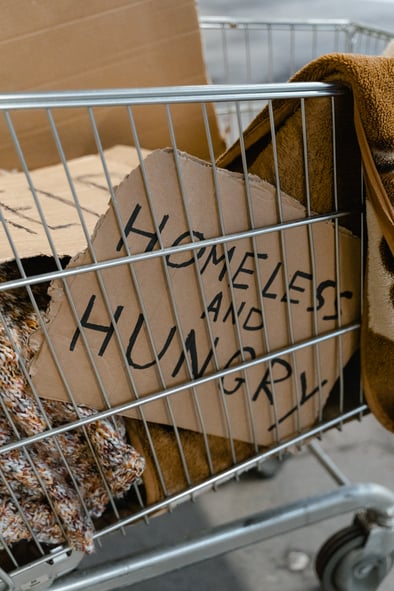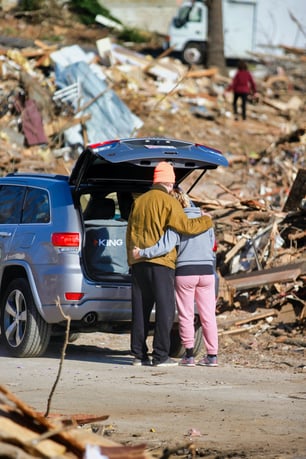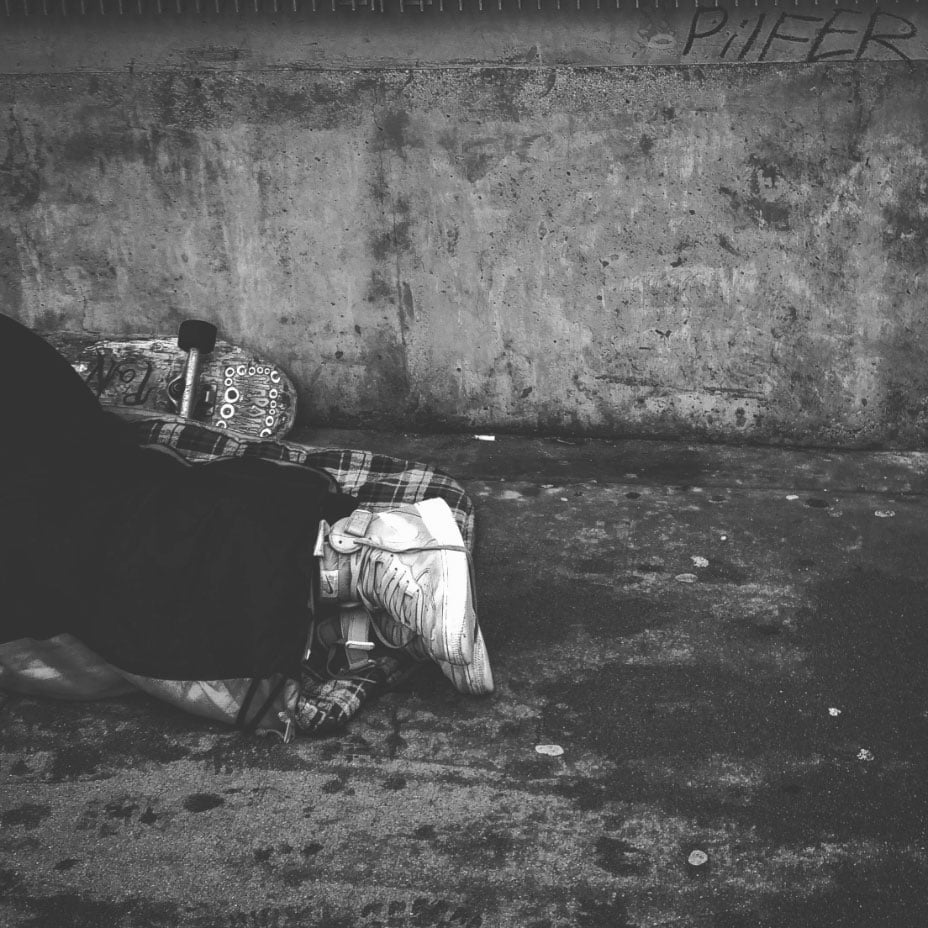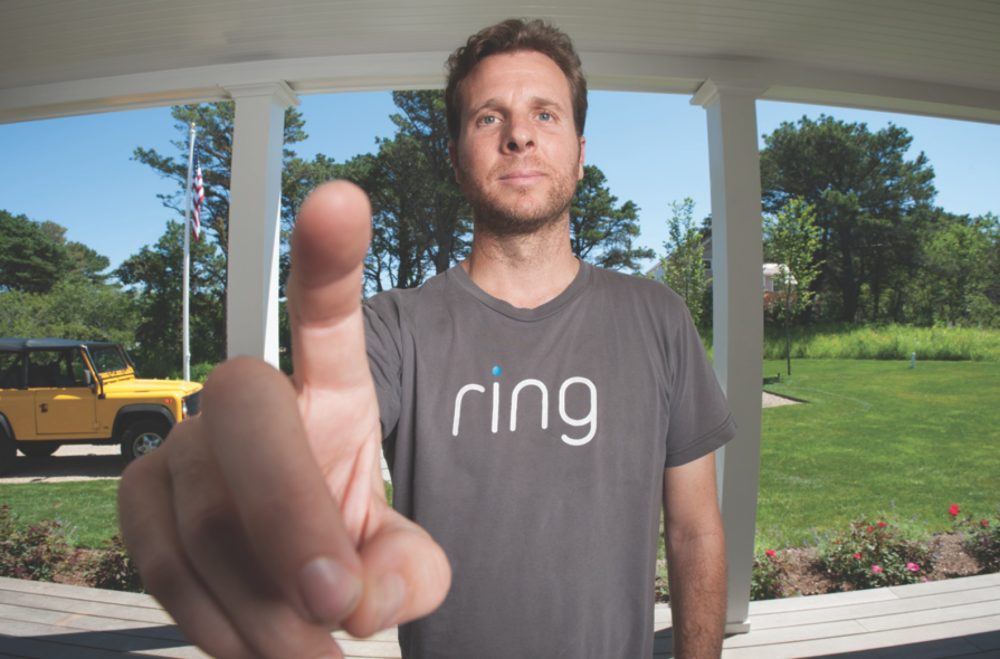Starving African children with thin arms and swollen stomachs. Haitian earthquake survivors crammed into shantytowns. Homeless men in shabby clothes sleeping rough in the winter cold.
Shocking images of human suffering are a mainstay of awareness and fundraising campaigns aimed at alleviating the worst effects of poverty. Whether the goal is to raise money for food, shelter, or disaster relief, nonprofits and NGOs have consistently relied on brutal photos and videos to communicate the urgency of the problems they face, and motivate donors to give.
However, this approach to fundraising—dubbed “poverty porn” by critics—has come under fire in recent years, as the beneficiaries of these programs speak out against the ways in which their pain has been used to collect money.

According to a widely accepted definition of the term proposed by journalist Matt Collins in 2009, poverty porn is "any type of media, be it written, photographed or filmed, which exploits the poor's condition in order to generate the necessary sympathy for selling newspapers, increasing charitable donations, or support for a given cause."
Critics claim that the use of such imagery in marketing campaigns is a form of exploitation, in that the public display of such photos can violate the privacy and dignity of the persons being photographed. Those who oppose the use of such images argue that they distort the truth, presenting only those aspects of a situation that are likely to arouse pity in potential donors, rather than offering a complete, accurate picture of the region or socioeconomic group being put on display.
With so many strikes against it, we might wonder why poverty porn continues to play such a big part in marketing and fundraising materials across a wide range of issue areas. Why didn’t nonprofits, NGOs, and other organizations abandon the approach long ago? Why continue to create campaigns that make entire populations seem needy, helpless, and in need of saving? Why greenlight communications strategies that deny the agency of the people one is trying to help?
Unfortunately, reevaluating our use of poverty porn isn’t as simple as agreeing to leave it behind for good. The messy truth is that, for all its very real shortcomings, disturbing, hyperbolic imagery has provided a lot of benefit to aid organizations over the years—making it especially difficult, even risky, to give up…
Poverty Porn Can Be Effective
It’d be one thing to eliminate poverty porn from our marketing materials if it clearly had a negative impact on fundraising. But evidence seems to suggest that the opposite is true—that donors do give more when they are exposed to dramatic images of human suffering, and that certain aid organizations might even be stuck using poverty porn in order to raise money for their clients.
In his study on images of homelessness, for instance, sociologist Jon Dean found that students tend to default to stereotypical images of “roofless” men when asked to draw a picture of “what homelessness looks like.” This, despite the fact that many of the students in his study were aware that the issue of homelessness is much larger and more complex than just rooflessness, encompassing wider problems like squatting and refugee camps.

Dean concluded that incomplete, stereotypical images of homelessness come to mind more readily than nuanced, in-depth understandings—and that this has implications for how aid organizations approach their marketing strategies. As he puts it:
“we see the findings of this research as potentially worrying, providing a rationale for fundraising strategies which continue to use stereotypical images and communicate only a small element of the realities of homelessness. The evidence presented above suggests that stereotypical, individualised, and depoliticised images are those most likely to stimulate recognition and, potentially, donations from the general public, yet perpetuate inaccurate understandings and a lack of empathy.”
In other words, relying exclusively on images of rough-sleeping men does promote an inaccurate picture of what homelessness really is—but organizations that fail to show such images to the public risk missing out on valuable donations that could make a difference to their homeless clients. More nuanced campaigns provide better education, but they might not raise as much money as those that try to evoke pity from potential donors.
As a result, mission-oriented marketers find themselves caught in a dilemma. Is it better to take the high road, and use an organization’s limited time and resources to educate the public on important issues? Or should marketers focus on purely pragmatic, short-term gains, sacrificing a bit of accuracy for the sake of raising badly needed funds?
While there are no easy answers, there are a few points that marketers might consider while deciding what kinds of imagery to include in their organizations’ marketing strategies.
What Makes Poverty Porn "Pornographic"?
At first, the term “poverty porn” sounds like little more than a slick turn-of-phrase—a sticky concept that readers can easily take away from the think piece or late show segment where they first heard it. But the comparison to pornography is, in fact, very revealing, highlighting some of the overlooked dynamics that come into play when a nonprofit or NGO uses poverty porn in their marketing materials.
As early as 1981, international development expert Jørgen Lissner was drawing parallels between pornography the ways that aid organizations sometimes use images of human suffering. As he explains in his New Internationalist article “Merchants of Misery”:
“In my definition, pornography is the exhibition of the human body and soul in all its nakedness, without any respect and piety for the person involved. The public display of an African child with a bloated kwashikorkor-ridden stomach in advertisements is pornographic, because it exposes something in human life that is as delicate and deeply personal as sexuality, that is, suffering. It puts people’s bodies, their misery, their grief and their fear on display with all the details and all the indiscretion that a telescopic lens will allow.”
In other words, graphic images of human suffering—particularly the suffering of the poor—can all too easily function as “pornography,” in the sense that they reduce human persons into stereotyped images designed to excite a particular response in viewers.
Just as conventional pornography is designed to manipulate arousal by presenting an exaggerated picture of human sexuality, poverty porn works by overloading the viewer with images of humans suffering from hunger, pain, fear, etc. in order to stimulate feelings of pity. In both cases, the subject viewing the imagery—say, a well-to-do American flipping through a Save the Children brochure—winds up inadvertently reducing the person in the photo or video into a object for consumption, something to look at because it produces a particular feeling (such as arousal, pity, horror, superiority, etc.).

This tendency in and of itself might be enough to give many marketers pause. But the issue of poverty porn gets even dicier when we consider that, historically, many of the disturbing images used in aid organizations’ marketing campaigns have been taken without the explicit, informed consent of the people being recorded.
At a minimum, then, organizations considering the use of graphic imagery should be careful about how they source their photographs, videos, audio recordings, and other media. Are the people involved fully aware that they are being recorded in what might be the most painful moments of their lives? If so, have they fully consented to such recordings, and given the organization permission to use their image in promotional materials?
Doing the work of obtaining that consent won’t solve all the issues presented by poverty porn, but it could help mitigate some of the further harm done when a vulnerable person’s image is stolen from them and displayed to the world against their will.
Poverty Porn and Activism
From a more strategic point of view, overreliance on poverty porn is also a risky long-term move for an organization to make, in that it can draw attention away from the broader issues that need to be addressed if more permanent solutions are ever going to be developed.
As development consultant Jim Schaffer points out in a 2016 editorial for Nonprofit Quarterly, “[poverty porn] misrepresents poverty. It leads to donations, but not to activism.”
In other words, while striking images of humans in pain may lead to temporary fundraising spikes, they do little to educate donors about why a given problem exists in the first place. Dean and Lissner echo this point in their own articles, with Lissner going so far as to say that “ good intentions simply aren’t enough if they are pursued with little or no regard for the political side effects, with little or no understanding of what such images do to the mentality, the attitudes, the political emotions and behaviour of their audience.”
Poverty porn arouses pity—but it doesn’t persuade reason. And without the full explanations that aid organizations are best positioned to provide, audiences can remain stuck in immature, incomplete points of view on important social issues, lacking the information they need to see the big picture and think critically.
All of this suggests that, in addition to thinking through the ethical implications of their marketing materials, aid organizations need to make some very pragmatic calculations about short- versus long-term gains when deciding on a marketing strategy. Tempting as it might be to churn out a campaign full of poverty porn and get a quick infusion of cash from pitying donors, such a tactic has an unseen long-term cost—namely a target audience that doesn’t understand the full depth of a given problem, and therefore can’t take a very active role in addressing it.
Alternatives to Poverty Porn
Suppose your organization has decided that poverty porn presents a potential for harm and long-term risk that outweighs any short-term fundraising benefits. Now what? How do you create a campaign that doesn’t rely so heavily on gruesome imagery, or even eliminates it entirely? What are the alternatives to poverty porn, and how effective are they?
One of the most powerful ways to update an organization’s messaging is to make the shift to “asset framing”—a communications strategy that highlights the goals and strengths of a client population, rather than jumping straight into their hardships and needs.

As author and social entrepreneur Trabian Shorters outlines in a 2018 interview with the Skillman Foundation, framing social issues in terms of the aspirations of affected people allows aid organizations to respect their inherent dignity, while still publishing campaigns that affect viewers emotionally and drive potential donors to action. In other words, asset framing solves many of the problems that come with the use of poverty porn, offering a pragmatic and ethically sound alternative.
Looking beyond fundraising campaigns to communications in general, another way to mitigate the negative effects of poverty porn is to create or participate in platforms that highlight the positive traits of populations and places that frequently get short-changed by nonprofit and NGO campaigns.
One of the clearest examples of such a platform is the Twitter hashtag #TheAfricaTheMediaNeverShowsYou. Launched in 2015 Somali-American student Diana Salah, the campaign serves as a central hub where Africans can share pictures, video, and other media that draw attention to the cultural achievements, economic prosperity, and natural beauty that get glossed over in oversimplified poverty porn campaigns.
By sharing pictures of high fashion, luxurious cuisine, avant-garde architecture, and other markers of wealth, participants offer a useful counterweight to the images featured in poverty porn, helping to create a more well-rounded picture of Africa that better reflects the lived reality of life on the continent. The campaign reveals that, just like every other place on Earth, Africa is home to a diverse population of human beings, living with a wide variety of opportunities and challenges—a set of experiences too distinct to be reduced to a single brochure.

-1.png)


